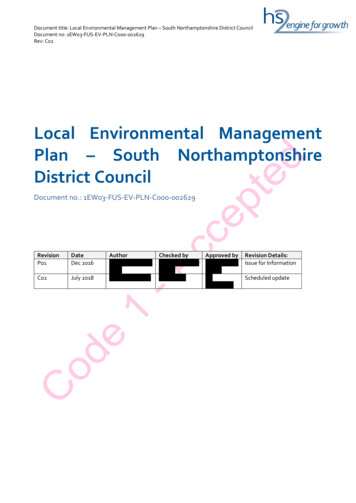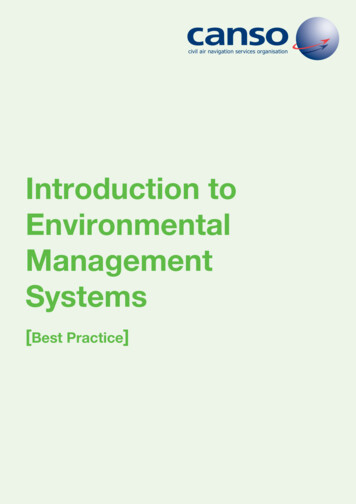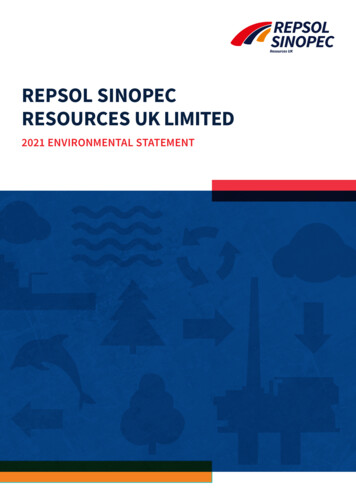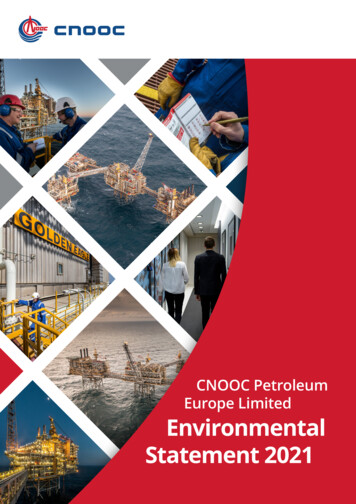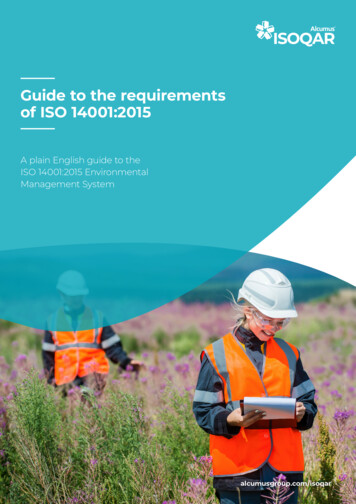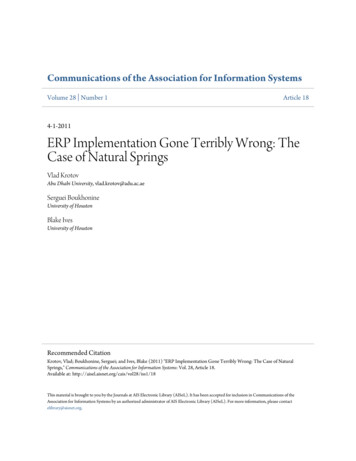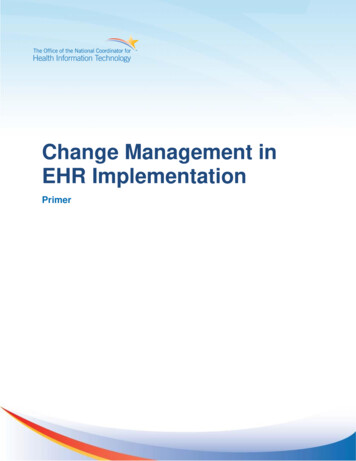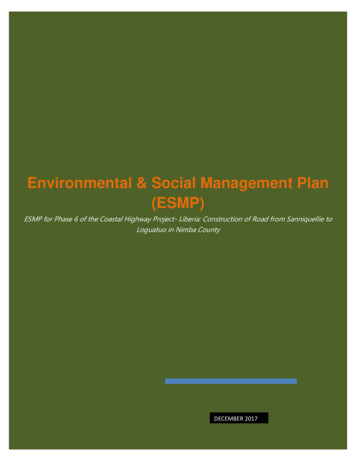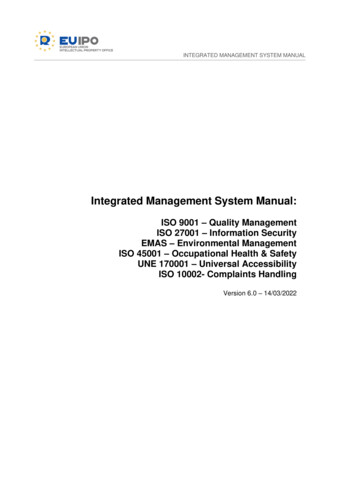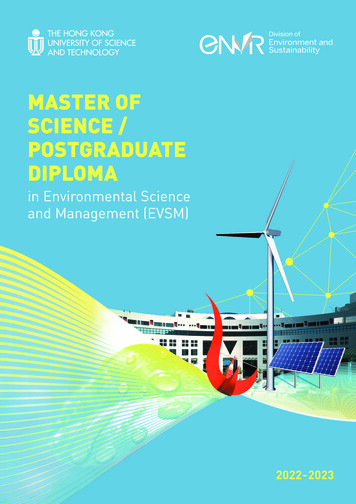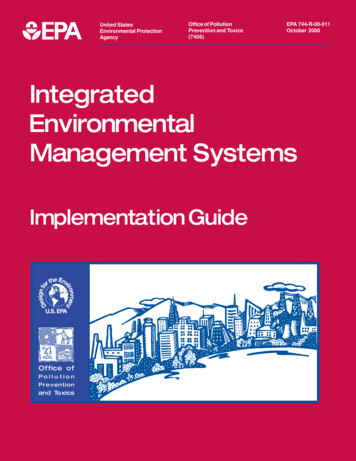
Transcription
United StatesEnvironmental ProtectionAgencyOffice of PollutionPrevention and Toxics(7406)EPA 744-R-00-011October 2000
Design for the Environment (DfE) ProgramEconomics, Exposure, and Technology DivisionOffice of Pollution Prevention and ToxicsUnited States Environmental Protection Agency(7406)Washington, DC 20460www.epa.gov/dfe
IntegratedEnvironmental Management SystemsImplementation GuideDesign for the Environment ProgramEconomics, Exposure, and Technology DivisionOffice of Pollution Prevention and ToxicsU.S. Environmental Protection AgencyFor further information about DfE’s Integrated Environmental Management SystemsPrograms, please contact:The Design for the Environment ProgramEconomics, Exposure, and Technology DivisionOffice of Pollution Prevention and ToxicsU.S. Environmental Protection Agency1200 Pennsylvania Avenue N.W. (MC 7406)Washington, D.C. 20460202-260-1678www.epa.gov/dfeTo order additional copies of this Guide, please contact EPA’s Pollution PreventionInformation Clearinghouse (PPIC) by phone (202-260-1023) or e-mail (ppic@epa.gov).You may also download this Guide from the Design for the Environment website(www.epa.gov/dfe).
AcknowledgmentsThis Guide is part of an effort to show how Design for the Environment (DfE) technicalwork can be used to support development of an Environmental Management System(EMS). This Guide is based primarily on EMS reference documents acknowledged inthe references section, and on DfE guidance documents such as the Cleaner TechnologiesSubstitutes Assessment Methodology. The Guide was prepared by Abt Associates Inc.,Cambridge, MA, with Jean E. (Libby) Parker as lead author. The Abt Associates projectteam included Cheryl Keenan, Dennis Chang, Susan Altman, and Jonathan Greene.The EPA Project Manager was Karen Chu, with the Design for the Environment Programin the Economics, Exposure and Toxics Division, Office of Pollution Prevention andToxics. Bill Hanson is Director of the Design for the Environment Program. Importantcontributions were made by Carol Hetfield, Heather Tansey, Ted Cochin, and JennyFisher, EPA.The Guide was developed in close collaboration with the Eastern Research Group, Inc.(ERG), Lexington, MA. The ERG project team included Jeff Cantin, Dave Galbraith, andOwen Davis. We would also like to acknowledge the important contributions of theUniversity of Tennessee’s Knoxville Center for Clean Products and Clean Technologiesand Tellus Institute. The University of Tennessee project team included Lori Kincaid,Mary Swanson, and Kerry Kelly. Karen Shapiro at Tellus Institute helped develop thecost comparison section and provided Appendix F. EPA's Pollution PreventionDivision's Environmental Accounting Project provided funding to Tellus for thiscontribution.Valuable insights also were provided by Marci Kinter and Dan Marx of theScreenprinting & Graphic Imaging Association International (SGIA), Fairfax, VA, andby Foster Knight and Bob Ferrone of The Lexington Group, Lexington, MA. Usefulcomments were received from William T. Engel, Jr. of the Strategic EnvironmentalManagement Institute at the University of Florida’s Center for Training, Research andEducation for Environmental Occupations (UF/TREEO), Gainesville, FL.
ContentsForewordiDfE Program Principles iiiFigure A: DfE Substitutes Tree ivFigure B: Pollution Prevention Hierarchy ivHow to Use This Guide vFigure C: IEMS Process viiiFigure D. Road Map between ISO 14001 and IEMSixMODULE 1: LAYING THE GROUNDWORKpage 1Figure 1-a. The Continuous Improvement Cycle page 2Figure 1-b. Functions to Include in Your IEMS Team page 7Figure 1-c. Examples of Environmental Aspects and Associated Impacts page 12Figure 1-d. How an Activity Becomes an Impact page 12Figure 1-e. Generic Process Map for Business Activities page 14Figure 1-f. Product X — Extended Responsibility page 15Figure 1-g. Input-Output Diagram for a Step in a Manufacturing Operation page 16Figure 1-h. Input-Output Diagram for a Copier page 16Figure 1-i. Input-Output Diagram for Cleaning a Printing Press page 17Figure 1-j. Inputs and Outputs of a Company’s Products and Services page 18MODULE 2: CREATING AN ENVIRONMENTAL POLICYpage 23MODULE 3: DETERMINING SIGNIFICANT ENVIRONMENTAL ASPECTS AND SETTINGOBJECTIVES page 35Figure 3-a: Ranking Symbols page 38Figure 3-b: Information on an MSDS page 41Figure 3-c: Screen Printing Exposure Pathways page 46Figure 3-d: Dry Cleaning Exposure Pathways page 47MODULE 4: EVALUATING ALTERNATIVESpage 62MODULE 5: SETTING TARGETS AND MEASURING SUCCESSFigure 5-a. Root Cause Diagrampage 92MODULE 6: DEVELOPING OPERATIONAL CONTROLSpage 88page 94MODULE 7: IMPLEMENTING YOUR IEMSpage 106Figure 7-a. Sample Environmental Management Project Plan page 107Figure 7-b. Sample Environmental Management Project Plan page 108MODULE 8: BUILDING ORGANIZATIONAL SUPPORT page 113Figure 8-a. Documentation Levels page 119Figure 8-b. Levels of stakeholder interest page 125MODULE 9: ESTABLISHING CONTINUING IMPROVEMENTpage 132
APPENDICESAPPENDIX A: GLOSSARY 142APPENDIX B: SAMPLE QUESTIONS TO ASK YOUR SUPPLIER 146APPENDIX C: EXAMPLE PERFORMANCE EVALUATION WORKSHEETS 148APPENDIX D: EXAMPLE ALTERNATIVES EVALUATION WORKSHEET 153APPENDIX E: ALTERNATIVES EVALUATION SAMPLE WORKSHEETS 160APPENDIX F: HOW TO EVALUATE COSTS AND SAVINGS OF ALTERNATIVES 182APPENDIX G: REFERENCES AND RESOURCES 195APPENDIX H: BLANK WORKSHEETS 202
ForewordEPA’s Design for the Environment (DfE) Program has over eight years of experiencebuilding voluntary partnerships with industry, public interest groups, universities,research institutions, and other government agencies to develop cleaner, safer alternativesto existing products and processes and to manage change in the systems businesses use toaddress environmental concerns. The DfE Program has developed technicalmethodologies that provide businesses with environmental, economic, and performanceinformation on traditional and alternative manufacturing methods and technologies.These approaches help businesses integrate environmental concerns into their dailybusiness activities so they can reduce cross media impacts, use energy and otherresources efficiently, better manage the risk associated with using hazardous chemicals,practice product and process responsibility, and integrate environmental and workersafety and health requirements. In addition, DfE has gained valuable experience incommunicating with a wide variety of people with varying degrees of technicalknowledge, and in establishing and maintaining diverse stakeholder groups. The DfEProgram is offering this experience to support the development of IntegratedEnvironmental Management Systems in companies.TipWords or phrases in bold type are defined in the Glossary (Appendix A).TipThe IEMS process described in this Guide will help you develop a results-oriented EMS, but it maynot include all steps or core elements necessary for ISO certification.An Environmental Management System (EMS) is a set of management tools andprinciples designed to guide the allocation of resources, assignment of responsibilitiesand ongoing evaluation of practices, procedures, and processes that a company needs tointegrate environmental concerns into its daily business practices. The EMS developedand outlined by the International Standards Organization (ISO) in their standardISO14001 is one such example. The ISO 14001 EMS provides a widely recognized setof principles and standards for integrating environmental management into qualitycontrol and other business activities. Although the principles discussed in this documentcan apply to any EMS based on a plan-do-check-act approach, this document usesISO14001 as a starting point. In addition to administrative procedures, steps toimplement an EMS involve some technical work, such as identifying and prioritizingenvironmental concerns, evaluating options for addressing those concerns, and measuringthe success of implementing those options. The ISO14001 standard does not specify howto carry out the technical work.i
TipAn Environmental Management System provides a systematic way to review and improve operationsfor better environmental performance and improved profitability, by setting up procedures thatensure the work gets done. An EMS requires both administrative and technical work.The DfE Program’s approach to creating an EMS provides the DfE Program’s technicalmethods to carry out the technical work of developing the EMS. The technical methodsto integrate cleaner technology business methods with the management methods requiredfor an EMS are presented in the DfE Program’s Integrated Environmental ManagementSystem (IEMS). This approach emphasizes reducing risk to humans and theenvironment, pollution prevention, and wise resource management. The DfE Programprinciples follow this section. Those elements of the EMS that require strictlymanagement or administrative expertise will be presented so as to demonstrate how themanagement and technical elements fit together. More detail on the managementelements will be found in other referenced sources. This Guide takes you and yourcompany through the IEMS creation process, step by step.Tip There are many types of organizations that could make use of this Guide.A company could use it to develop an IEMS.A trade association could customize it and develop a sector-based approach to providetraining for their members.A large company could use it to green their supply chain and their customer chain.Federal facilities can use it to fulfill requirements in the Executive Order: Greening of theGovernment Through Leadership in Environmental Management.Other government facilities could use it to comply with environmental regulations and to bemore environmentally proactive.In January 1999, the DfE Program teamed with the Screenprinting and Graphic ImagingAssociation International (SGIA) to conduct a pilot project with seven screenprintingcompanies who wanted to develop IEMSs. The pilot project was designed to enable boththe DfE Program and SGIA to further develop these training materials. This Guide hasundergone major revisions, and the Company Manual Template was developed inresponse to lessons learned during the pilot project.ii
DfE Program PrinciplesA goal of the DfE Program is to create healthier environments for workers, communities,and the ecosystem. The DfE Program accomplishes this goal by promoting systemchange in the way a company manages environmental concerns. The DfE Programprinciples and approaches are useful in meeting regulatory requirements and augmentingenvironmental protection beyond compliance. Using the DfE Program’s approach canhelp a company integrate environmental protection by: managing the risk associated with using regulated and unregulated hazardouschemicals,considering cross-media impacts of activities and products,using energy and other resources efficiently,practicing extended product and process responsibility, andintegrating environmental and health & safety requirements.ApproachThe DfE approach to creating an IEMS has six main steps: Identify and compare alternatives to evaluate trade-offs and information gaps.Use the DfE Substitutes Tree outline (see Figure A) to evaluate alternatives.Use the Pollution Prevention Hierarchy (Figure B) to evaluate and rankapproaches.Integrate environmental considerations into daily business decision making thatincludes performance and cost to provide environmental solutions that promotecompetitiveness.Recognize need for a commitment to continuous improvement.Work in partnership with stakeholders; engage participation and support ofemployees; encourage open communication.iii
Figure A: DfE Substitutes TreeAlternatives to Accomplish FunctionOptionsEvOption 1Alternative ChemicalsOption 2Alternative ProcessesEnvironmentalIssueOption 3DescribeFunctionAlternative TechnologiesFigure B: Pollution Prevention HierarchyAlternative Work PracticesSOURCE REDUCTIONSubstitutesProcess ChangeManagement Work vaEnvEffePerCos
How to Use This GuideThis Guide has been designed to help companies integrate environmental concerns intobusiness decision making using the DfE Program’s Integrated EnvironmentalManagement System (IEMS). This Guide follows the guidelines of ISO14001, aninternational standard for EMSs, and it is designed to help businesses set up andimplement a simple, straightforward EMS. This Guide does not intend to give guidancefor ISO14001 certification.This Guide is laid out in nine modules designed to be completed through groupdiscussions with your IEMS team members and other managers and employees asappropriate. Most modules can be completed in several hours, but some may take longer.Sessions may be held once a week, once every other week, or once a month until the jobis done. Use whatever time these modules require for your company. It is moreimportant to complete each module than to finish in any particular time frame. Mostcompanies find that it takes about a year to work through the EMS development process.And it generally takes up to three years for the EMS to be fully understood andimplemented. Developing a company IEMS is a commitment to change, and changetakes time.TipEvery choice you and your employees make can affect the environment. Involving everyone helpsproduce cost-effective long-term results.Best results will be achieved by involving everyone in the company in some way. Thereare two benefits to involving all employees: first, they will be more likely to takeownership of managing environmental concerns; second, they often have valuable insightinto how improvements can be made.TipYou should not try to perfect each step on your first attempt. Many of the steps will need to berevisited as you proceed with developing the IEMS.You should consider regular sessions as suits your schedule to complete the work in eachmodule. You will need to appoint a responsible person and a committee to head thedevelopment of your IEMS. The committee members could also meet regularly withother employees to provide progress reports and solicit input. The importance of regularcommunication and involvement cannot be overemphasized. Getting people to thinkabout environmental concerns in their daily work is as important a process as any step insetting up your IEMS.v
TipA companion document, A Company Manual Template, contains sample procedures and formats tohelp you document important components of your IEMS. Refer to this Guide frequently as youdevelop your IEMS. This document is available on the DfE website (www.epa.gov/dfe). SeeAppendix G for details about the Template.Some of these modules will have to be revisited during the process. For example, it isuseful to develop a communication plan in the beginning, but you will need to add to it asenvironmental concerns are identified and as other parts of the IEMS are developed.Some modules may not be completed at the outset, but may be revised as neededthroughout the process.Finally, you don’t need to do everything at once. This Guide will help you identifypossible projects and then help you prioritize these projects, given your resources andtime. You may, for example, want to start out by developing the IEMS for only one partof your company or operation. You can expand later as your resources permit. It’simportant to start small with projects that will achieve success, so that you and youremployees gain experience with the process and build confidence in your ability to makechanges.What are the Steps in Developing an IEMS?Each module in this Guide explains a step in the IEMS development process. Themodules contain worksheets to assist you in completing this work. Figure C is a flowchart showing the steps in the process. Figure D is a “roadmap” showing how the IEMSmodules relate to the components of the ISO 14001 standard. The Appendices contain aGlossary, example questions to ask your suppliers about chemical risk, an alternativesevaluation worksheet and performance evaluation worksheet from the DfE PrintingProject, resources for more information, and blank forms that correspond to theworksheets in each module. In addition to the Appendices, more tools and guidance canbe found on the DfE's website at www.epa.gov/dfe. In particular, there is a moreextensive Risk Guide and Cleaner Technology Substitutes Assessment Guide.Module 1: Laying the GroundworkThis module provides a general discussion of what an IEMS contains. It will help youbuild understanding of and support for your IEMS among your company’s managers andemployees, about what an IEMS is and why the company is developing one. Thismodule also will help you understand how your company currently impacts theenvironment by identifying environmental impacts of your company’s products,processes and services.vi
Module 2: Creating an Environmental PolicyAn early step in the process of developing a IEMS is reviewing your company’s currentmethods for managing environmental concerns. Next you will write your company’senvironmental policy statement and decide on the scope of your IEMS. Theenvironmental policy will be based on what is important to your company. This modulecontains some sample principles and policy statements.Module 3: Determining Significant Environmental Aspects and SettingObjectivesYou will need to determine which environmental aspects are significant, and prioritizethem to determine what you want to address first. This module provides a method toestimate environmental risk to help you prioritize environmental aspects. The modulethen helps you to translate those priorities into objectives to reduce environmentalimpact.TipEnvironmental aspects are elements of your business, such as air pollutants or hazardous waste,that can have negative impacts on people and/or the environment.vii
Figure C: IEMS ProcessDevelop ProcessMap andIdentify AspectsLay the GroundworkCreate EnvironmentalPolicy StatementReviewandUpdateGaps AnalysisDetermine Significant AspectsConsider Environmental RiskSet Objectives,Determine ActionsChange Current ActivityImprove Current ActivityEvaluate AlternativesOperational ControlsSet Targets and Project MeasurementCriteriaImplement the SystemContinuousImprovementEstablish Continuing ImprovementviiiEstablishEnvironmentalManagement ProjectsEstablishProgramMeasurementCriteria
Figure D: Road Map Between ISO 14001 and IEMS ApproachISO14001 EMS COMPONENTSIEMS GUIDE MODULESCommitment and PolicyModule 1: Laying the GroundworkModule 2: Creating an Environmental PolicyPlanningModule 1: Laying the GroundworkModule 3: Determining Significant Environmental Aspects andSetting ObjectivesImplementationModule 4: Evaluating AlternativesModule 5: Setting Targets and Measuring SuccessModule 6: Developing Operational ControlsModule 7: Implementing Your IEMSModule 8: Building Organizational SupportEvaluationModule 5: Setting Targets and Measuring SuccessModule 8: Building Organizational SupportReviewModule 9: Establishing Continuing ImprovementModule 4: Evaluating AlternativesBefore deciding how you will meet your objectives, it is important to consider a widearray of approaches. This module shows how the IEMS methodology considers ahierarchy of alternatives, which include substitutes, pollution prevention, and wiseresource management.Module 5: Setting Targets and Measuring SuccessFor those significant environmental aspects where you have set an objective, you willneed to develop specific targets that describe how you will achieve your goal and youneed to develop ways of measuring that achievement.Module 6: Developing Operational ControlsFor some environmental aspects, you will need to write procedures to ensure thatactivities are performed in a way that reduces environmental impact. This module laysout how to develop operational controls, measure for success of those controls, andprovide corrective action when necessary.Module 7: Implementing Your IEMSEffective implementation is essential to getting your IEMS off to a good start. Thismodule helps you plan the IEMS development process and set up environmentalmanagement projects for your objectives.ix
Module 8: Building Organizational SupportThe long-term success of your IEMS will depend on solid organizational support. Suchsupport includes developing documentation, meeting training needs, and implementingeffective communication and stakeholder involvement processes.Module 9: Establishing Continuing ImprovementTo ensure success and continuing improvement, regular reviews of your overall IEMSare needed. These reviews include progress made in communication, documentation anddeveloping stakeholders as well as the specific environmental targets. The reviewsprovide critical information to ensure continuing improvement.How much work each of the steps entails depends entirely on the scope of work that youdecide to undertake. It is not necessary for your IEMS to include all your operations,especially for your first effort. As you gain experience in managing environmentalconcerns along with your daily operations, you will develop your IEMS further.x
Module 1: Laying the GroundworkThis module contains an overview of Environmental Management Systems, suggestionsfor how to build internal support for your IEMS, ideas for developing your IEMSmanagement team, and a process for understanding how your company impacts theenvironment.Overview of Environmental Management SystemsAn Environmental Management System (EMS) provides a systematic way to reviewand improve operations for better environmental performance. An EMS can help acompany better meet its compliance requirements. It can also help a company usematerials more efficiently and streamline operations, thereby reducing costs andbecoming more competitive.TipAn EMS is a framework for managing those significant environmental aspects you can control orinfluence.A commonly used framework for an EMS is the one developed by the InternationalOrganization for Standardization (ISO) for the ISO 14001 standard. Although the EMSdescribed in this Guide is based on the ISO 14001 approach, the process outlined in thisGuide may not provide for meeting all the requirements of ISO 14001 certification. Thepurpose of this Guide is not to give advice towards certification. It is to demonstrate atechnical means of integrating environmental concerns into company management so thatbusinesses can become more effective in reducing their impact on the environment.TipWords in bold type can be found in the Glossary (Appendix A).In addition, other guides on the market provide useful approaches. Developing an IEMSbased on this Guide does not imply endorsement by the U.S. EPA.TipFor more information on ISO 14001 EMS, check Appendix G (References and Resources).The five main stages of an EMS, as defined by the ISO 14001 standard, are as follows. Commitment and policy — top management commits to environmentalimprovement and establishes a company environmental policy.1
Planning — the company conducts a review of its operations, identifies legalrequirements and environmental concerns, establishes objectives, evaluatesalternatives, sets targets, and devises a plan for meeting those targets.Implementation — the company follows through with the plan by establishingresponsibilities, training, communication, documentation, operating controlprocedures, and an emergency plan to ensure that environmental targets are met.Evaluation — the company monitors its operations to evaluate whether the targetsare being met, and, if not, takes corrective action.Review — the EMS is modified to optimize its effectiveness. The review stagecreates a loop of continuous improvement for the company (Figure 1-a).TipContinuously identifying and reducing risk leads to improved competitiveness and environmentalperformance.Figure 1-a. The Continuous Improvement CycleCommitmentand nImplementation2
The advantage of adopting the DfE Program approach is that it enables your company toconsider and plan for managing the environmental risk of your company’s products,processes and services. The method outlined in this Guide will help your companycompare alternatives to identify the least cost, best performing and lowest environmentalimpact option. This approach will help your company do the following: practice pollution prevention,use resources efficiently,avoid shifting problems from one waste stream to another,understand the risks associated with using both regulated and unregulatedchemicals,integrate management of worker safety and health requirements with managementof environmental concerns,practice extended product and process responsibility, andmanage system change in addressing environmental concerns.Screenprinters from the SGIA/EPA IEMS Pilot Project have this to say about whatthey learned:“That you can have a system to achieve environmental improvement. Never gave it much thoughtbefore.”“Changed from being reactive to environmental regulations to being more proactive.”“The benefits of having documented operational controls.”“General environmental awareness building across the board; and that you can be bottom-line orientedand environmentally conscious at the same time.”“That the ultimate benefit is improving the environment and improving the bottom line at the same time.”Thus, by using the approach provided in this Guide, you can develop a IEMS that helpsyou continuously identify and reduce risks to people and the environment. This Guideprovides methods to help you consider risk reduction when answering the followingquestions. How does your company impact the environment?Which of these environmental impacts are significant?How can your company improve its environmental performance?3
Building Support for Your IEMSBoth management and employees need to understand not only what a IEMS is, but alsowhy they would want one. This step is designed to get people to think about and discussthe ways in which a IEMS would benefit your company. Even though you may alreadyhave management support, it is still important to get employee buy-in to this process.Through years of working with companies, the DfE Program has learned the importance of buildingsupport from participants through open and frequent discussion about mutual concerns.Set up times to discuss your company’s need for a IEMS with key managers andemployees. Recording the discussions provides important documentation, which can beused to communicate the benefits of your IEMS to others. One way to record thediscussion is to assign someone the task of writing the group’s comments on a flip chart,so that everyone can see them for discussion. The following set of general questions willlead you through the discussion.Discussion Questions1.2.3.4.5.Which environmental and worker safety laws and regulations is your companyrequired to follow?How does your company define environmental performance?Does lack of time or resources prevent your organization from taking charge of itsenvironmental obligations? Are there individuals appointed to be responsible forthis function?What is your company’s environmental policy?Does your organization know how its environmental objectives relate to itsbusiness objectives?1To build support, consider the benefits a IEMS might provide for your company. A moresystematic approach to meeting your environmental and business goals might contributeto the following in your company: improved environmental performanceimproved worker health and safetyimproved competitiveness1Adapted from: Environmental Management Systems: An ImplementationGuide for Small and Medium-Sized Organizations. Ann Arbor, MI: NSFInternational, November 1996, p.3.4
improved compliance and reduced liabilityfewer accidentslower insurance premiumsimproved public imageenhanced customer trustbetter access to capitalimproved internal communicationimproved company moralereduced operating costsTipTo help get facility-wide buy-in to the IEMS process, find the workers who are most enthusiasticwith the process and recruit them to spread the word among their peers. Commitment from topmanagement is essential, but you also need promoters at all levels of your company.It will be helpful at this point to create a worksheet comparing the expected costs andbenefits of developing a IEMS. Worksheet 1-1 provides some general categories of costsand benefits. When making your comparison, provide specific examples from thediscussion.Assigning Responsible PersonsDesignate, as soon as possible, the Management Representative, the IEMS Coordinator,and a Committee who will be responsible for promoting and developing your IEMS. Ifyou have a very small company, these may all be the same person! However, it is stillimportant to designate who will be responsible for various activities. Worksheet 1-2provides a means to document the responsible persons. This worksheet can be placed inyour Company IEMS Manual (see the Company Manual Template).5
Worksheet 1-1: Costs and Benefits of Developing and Implementing an IEMS2CostsBenefits Staff/employee time for:collecting informationreading and understanding this Guidepreparing worksheetsfacilitating IEMS sessionsparticipating in IEMS development Possible consulting assistance Training of personnel in new procedures Technical resources to analyze environmentalimpacts and improvement options Resources required to make changesContact Person:Improved environmental performanceExpected increased efficiency/reduced cost ofmaterials New customers/markets Enhanced employee morale Expected savings in compliance and overallcompliance monitoring and assessment, andrecord-keeping requirements due to changes inmaterials used Reduced waste disposal/treatment costs
To order additional copies of this Guide, please contact EPA's Pollution Prevention Information Clearinghouse (PPIC) by phone (202-260-1023) or e-mail (ppic@epa.gov). . An Environmental Management System (EMS) is a set of management tools and principles designed to guide the allocation of resources, assignment of responsibilities .
